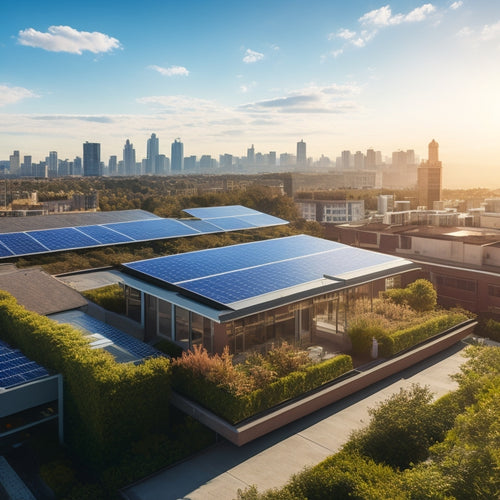
Create Your Own DIY Solar Panel Kit at Home
Share
You can create your own DIY solar panel kit at home by understanding the photovoltaic effect, selecting efficient components, and assembling them safely. Choose solar panels with high efficiency ratings, a suitable charge controller, and an inverter to convert DC to AC power. Guarantee a well-organized workspace, handle solar cells carefully, and connect bus wires without touching electrical components. Once assembled, install the solar panel securely on your rooftop, prioritizing safety in wiring. With your kit up and running, track energy production to optimize performance and analyze consumption patterns to maximize energy savings - and that's just the beginning of your DIY solar journey.
Key Takeaways
• Choose efficient solar panels with high efficiency ratings (>20%) for maximum energy output and consider warranty, durability, and customer support.
• Ensure a well-organized workspace and handle solar cells carefully to prevent damage when assembling the DIY kit.
• Mount the solar panel securely on a rooftop or support structure to maximize sunlight capture, and prioritize safety in wiring with secure connections.
• Install a monitoring system to track energy production and consumption in real-time, and analyze data to optimize system performance and identify efficiency opportunities.
• Consider energy storage options like batteries or supercapacitors to store excess energy generated by the solar panel kit.
Understanding Solar Panel Basics
When you begin constructing your DIY solar panel kit, it's important to understand the fundamental principles of solar panels, starting with the photovoltaic (PV) effect, which converts sunlight into electrical energy. This process occurs when photons from sunlight interact with the semiconductor material in the solar panel, exciting electrons and generating an electric current. Efficiency factors, such as the type of semiconductor material, panel angle, and temperature, greatly impact the amount of energy generated.
Understanding these factors is essential to optimize your DIY solar panel kit's performance. Additionally, energy storage is a crucial component to take into account, as it allows you to store excess energy generated during the day for use during the night or on cloudy days. You'll need to choose the right energy storage system, such as batteries or supercapacitors, to ensure a reliable and efficient power supply.
Choosing the Right Components
With your fundamental understanding of solar panels in place, you'll now need to select the right components for your DIY solar panel kit, including solar panels, a charge controller, an inverter, and energy storage devices, each of which plays a critical role in harnessing and utilizing solar energy effectively.
When choosing solar panels, consider Efficiency Ratings, which impact how much energy you'll generate per hour of sunlight. Look for high-efficiency panels (>20%) for maximum energy output.
| Brand | Efficiency Rating |
|---|---|
| SunPower | 22.8% |
| Panasonic | 21.8% |
| Trina Solar | 20.5% |
| Hanwha Q CELLS | 20.3% |
In addition to solar panels, you'll need a charge controller to regulate energy flow, an inverter to convert DC to AC power, and energy storage devices like batteries to store excess energy. Research and compare different brands, considering factors like warranty, durability, and customer support to make sure you're getting the best components for your DIY solar panel kit.
Assembling the DIY Kit
You've selected the right components for your DIY solar panel kit, now it's time to assemble them into a functional system that can harness and convert sunlight into usable electricity.
Before you begin, make sure you have a well-organized workspace with all the necessary tools within reach. Proper tool organization is essential to avoid mistakes and injuries.
Start by connecting the solar cells to the substrate, making sure to handle them carefully to prevent damage. Next, connect the bus wires to the cells, taking care not to touch any electrical components with your bare hands.
Safety precautions are paramount when working with electrical systems, so always wear protective gear and avoid overreaching or stretching.
As you assemble the kit, double-check each connection to ensure they're secure and meet the manufacturer's specifications. A well-assembled kit will maximize energy output and minimize the risk of electrical shock or fire hazards.
Installing the Solar Panel
Mount the assembled solar panel kit securely to a sturdy rooftop or a freestanding support structure, making certain it's angled and positioned most efficiently to capture the maximum amount of sunlight.
Before installation, verify you've completed thorough roof preparation, checking for any damaged, rotten, or loose roofing material that could compromise the solar panel's stability. Clear the area of debris, and confirm the surface is dry and clean.
When it comes to wiring, prioritize safety above all. Confirm all connections are secure, and wires are properly insulated to prevent electrical shock or fire hazards. Use weather-resistant connectors and seals to protect the system from environmental elements.
Consider hiring a licensed electrician if you're not confident in your wiring abilities. As you install the solar panel, take note of the wiring diagram provided with your kit, and double-check your work to guarantee a safe and efficient connection.
Monitoring Energy Savings
As you flip the switch on your newly installed DIY solar panel kit, it's important that you track your energy production to optimize your system's performance and gauge the impact on your utility bills.
Monitoring your energy savings is vital to understanding the effectiveness of your solar panel kit. You can do this by installing a monitoring system that provides real-time data on your energy production and consumption. This data will help you identify areas of inefficiency and make adjustments to maximize your energy savings.
Energy tracking allows you to analyze your energy production and consumption patterns, providing valuable insights into your energy usage. By analyzing this data, you can identify opportunities to reduce your energy consumption and optimize your solar panel kit's performance.
A cost analysis of your energy savings will also help you understand the financial benefits of your DIY solar panel kit. By tracking your energy savings, you'll be able to see the direct impact of your solar panel kit on your utility bills, giving you a clear understanding of your return on investment.
Frequently Asked Questions
Can I Use a DIY Solar Panel Kit for My RV or Boat?
'When you're planning marine adventures, you'll want reliable off-grid freedom. Yes, you can use a DIY solar panel kit for your RV or boat, but make sure it's designed for marine use, with waterproof components and a durable mounting system.'
How Long Does a DIY Solar Panel Kit Last?
"When you invest in a DIY solar panel kit, you expect it to last; with proper maintenance, a well-built system can provide energy efficiency for 25 years or more, ensuring system durability and a reliable power supply for your RV or boat."
Can I Expand My DIY Solar Panel Kit Later?
You can easily expand your DIY solar panel kit later, thanks to its modular design, allowing for future upgrades and ensuring system scalability, so you can increase power output as your energy needs grow.
Are DIY Solar Panel Kits Compatible With Existing Electrical Systems?
"A million possibilities unfold as you integrate your DIY solar panel kit with existing electrical systems, ensuring seamless system integration and boosting energy efficiency, allowing you to harness the power you crave."
Do I Need Special Permits to Install a DIY Solar Panel Kit?
You'll need to check local regulations, building codes, neighborhood covenants, and homeowners association rules to determine if special permits are required to install your DIY solar panel kit, ensuring compliance with authorities.
Related Posts
-

5 Essential Tips for Buying EV Charging Systems Online
When purchasing an EV charging system online, you'll want to make sure you're making an informed decision. First, det...
-

Eco-Friendly Car Battery Solutions Available Online
You can now shop online for eco-friendly car battery solutions that not only reduce your carbon footprint but also of...
-

What Is the Cost to Put in Solar Panels
You're likely considering solar panels for your home, and the most significant factor in your decision is the upfront...


